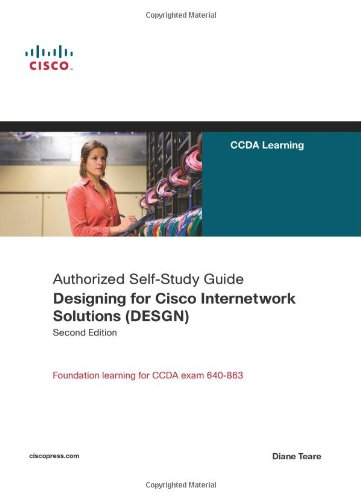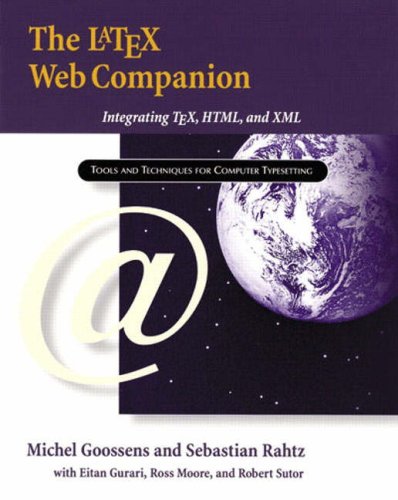Diane Teare9781587052729, 1587052725
Table of contents :
Designing for Cisco Internetwork Solutions (DESGN), Second Edition……Page 1
Contents……Page 9
Foreword……Page 27
Introduction……Page 28
Introduction to Networks……Page 34
Protocols and the OSI Model……Page 35
The OSI Model……Page 36
The OSI Layers……Page 37
Communication Among OSI Layers……Page 40
LANs and WANs……Page 42
Terminology: Domains, Bandwidth, Unicast, Broadcast, and Multicast……Page 44
Switches……Page 45
Routers……Page 47
Introduction to the TCP/IP Suite……Page 48
TCP/IP Transport Layer Protocols……Page 49
TCP/IP Internet Layer Protocols……Page 55
Routing……Page 58
Routers Work at the Lower Three OSI Layers……Page 59
Routing Tables……Page 60
Physical Addresses……Page 62
Logical Addresses……Page 63
Routing and Network Layer Addresses……Page 64
IP Addresses……Page 65
Layer 2 Switching……Page 69
Layer 3 Switching……Page 72
Redundancy in Layer 2 Switched Networks……Page 73
STP Terminology and Operation……Page 74
Virtual LANs……Page 78
VLAN Membership……Page 79
STP and VLANs……Page 80
Inter-VLAN Routing……Page 82
Comprehensive Example……Page 83
Summary……Page 86
Business Drivers for a New Network Architecture……Page 88
Intelligence in the Network……Page 89
Cisco SONA Framework……Page 91
Design as an Integral Part of the PPDIOO Methodology……Page 95
Benefits of the Lifecycle Approach to Network Design……Page 97
Design Methodology……Page 98
Assessing the Scope of a Network Design Project……Page 100
Identifying Required Information……Page 101
Planned Applications and Network Services……Page 104
Organizational Goals……Page 106
Organizational Constraints……Page 109
Technical Goals……Page 111
Technical Constraints……Page 112
Customer Input……Page 114
Auditing or Assessing the Existing Network……Page 118
Tools for Assessing the Network……Page 120
Analyzing Network Traffic and Applications……Page 126
Tools for Analyzing Traffic……Page 127
Network Health Checklist……Page 133
Summary Report……Page 134
Creating a Draft Design Document……Page 135
Time Estimates for Performing Network Characterization……Page 136
The Top-Down Approach to Network Design……Page 138
Top-Down Design Example……Page 139
Decision Tables in Network Design……Page 141
Structured Design……Page 143
Network Design Tools……Page 145
Building a Prototype or Pilot Network……Page 146
Documenting the Design……Page 147
Planning a Design Implementation……Page 148
Monitoring and Redesigning the Network……Page 150
References……Page 151
Case Study Scenario……Page 152
Case Study Questions……Page 155
Review Questions……Page 156
Hierarchical Network Model……Page 160
Access Layer Functionality……Page 162
Distribution Layer Functionality……Page 165
Core Layer Functionality……Page 167
Hierarchical Routing in the WAN……Page 170
Evolution of Enterprise Networks……Page 171
Functional Areas of the Cisco Enterprise Architecture……Page 172
Guidelines for Creating an Enterprise Network……Page 176
Enterprise Campus Modules……Page 177
Enterprise Edge Modules……Page 181
Service Provider Modules……Page 186
Remote Enterprise Modules……Page 188
Interactive Services……Page 190
Security Services in a Modular Network Design……Page 193
High-Availability Services in a Modular Network Design……Page 200
Voice Services in a Modular Network Design……Page 208
Wireless Services in a Modular Network……Page 212
Application Networking Services in a Modular Network Design……Page 214
Network Management Architecture……Page 217
SNMP……Page 219
MIB……Page 223
RMON……Page 228
Netflow……Page 233
CDP……Page 236
Syslog Accounting……Page 238
Summary……Page 242
Case Study: ACMC Hospital Modularity……Page 243
Review Questions……Page 246
Designing an Enterprise Campus……Page 252
Network Application Characteristics and Considerations……Page 253
Environmental Characteristics and Considerations……Page 259
Infrastructure Device Characteristics and Considerations……Page 266
Enterprise Campus Design……Page 276
Building Access Layer Design Considerations……Page 277
Building Distribution Layer Design Considerations……Page 284
Campus Core Design Considerations……Page 288
Server Placement……Page 294
The Enterprise Data Center……Page 299
The Cisco Enterprise Data Center Architecture Framework……Page 300
Enterprise Data Center Infrastructure……Page 303
Summary……Page 307
Case Study: ACMC Hospital Network Campus Design……Page 308
Case Study Additional Information……Page 309
Case Study Questions……Page 310
Review Questions……Page 320
Introduction to WANs……Page 324
WAN Interconnections……Page 325
Traditional WAN Technologies……Page 326
WAN Transport Technologies……Page 329
WAN Transport Technology Pricing and Contract Considerations……Page 345
WAN Design……Page 347
Application Requirements of WAN Design……Page 348
Technical Requirements: Maximum Offered Traffic……Page 350
Technical Requirements: Bandwidth……Page 351
Evaluating the Cost-Effectiveness of WAN Ownership……Page 352
Optimizing Bandwidth in a WAN……Page 353
Remote Access Network Design……Page 363
VPN Design……Page 364
WAN Backup Strategies……Page 369
The Internet as a WAN Backup Technology……Page 372
Enterprise Edge WAN and MAN Architecture……Page 374
Enterprise Edge WAN and MAN Considerations……Page 375
Cisco Enterprise MAN and WAN Architecture Technologies……Page 376
Cisco IOS Software Packaging……Page 379
Enterprise Branch and Teleworker Design……Page 383
Enterprise Branch Architecture……Page 384
Enterprise Branch Design……Page 386
Enterprise Teleworker (Branch of One) Design……Page 393
Summary……Page 395
References……Page 396
Case Study Additional Information……Page 397
Case Study Questions……Page 399
Review Questions……Page 403
Private and Public IPv4 Addresses……Page 408
Determining the Size of the Network……Page 412
Planning the IP Addressing Hierarchy……Page 415
Methods of Assigning IP Addresses……Page 426
Name Resolution……Page 431
DHCP and DNS Server Location in a Network……Page 434
Introduction to IPv6……Page 435
IPv6 Features……Page 436
IPv6 Address Format……Page 437
IPv6 Address Types……Page 439
IPv6 Address Assignment Strategies……Page 443
IPv6 Name Resolution……Page 445
IPv4-to-IPv6 Transition Strategies and Deployments……Page 446
IPv6 Routing Protocols……Page 450
Summary……Page 453
Case Study: ACMC Hospital IP Addressing Design……Page 454
Review Questions……Page 457
Routing Protocol Features……Page 460
Static Versus Dynamic Routing……Page 461
Interior Versus Exterior Routing Protocols……Page 463
Distance Vector Versus Link-State Versus Hybrid Protocols……Page 464
Routing Protocol Metrics……Page 469
Routing Protocol Convergence……Page 472
Flat Versus Hierarchical Routing Protocols……Page 475
EIGRP……Page 477
OSPF……Page 480
Integrated IS-IS……Page 484
Summary of Interior Routing Protocol Features……Page 486
Selecting an Appropriate Interior Routing Protocol……Page 487
Border Gateway Protocol……Page 488
Routing Protocols in the Enterprise Architecture……Page 492
Route Redistribution……Page 495
Redistributing and Filtering with BGP……Page 501
Route Summarization……Page 502
References……Page 505
Review Questions……Page 506
Analog and Digital Signaling……Page 510
PBXs and the PSTN……Page 514
Local Loops, Trunks, and Interswitch Communications……Page 518
Telephony Signaling……Page 520
PSTN Numbering Plans……Page 526
Introduction to Integrated Networks……Page 531
H.323……Page 534
Introduction to IP Telephony……Page 539
Call Control and Transport Protocols……Page 545
Voice Quality Issues……Page 552
Voice Coding and Compression……Page 560
Bandwidth Considerations……Page 564
QoS for Voice……Page 567
Introduction to Voice Traffic Engineering……Page 576
Terminology……Page 577
Erlang Tables……Page 579
Calculating Trunk Capacity or Bandwidth……Page 583
Summary……Page 584
References……Page 585
Case Study: ACMC Hospital Network Voice Design……Page 586
Case Study Questions……Page 587
Review Questions……Page 588
Introduction to Wireless Technology……Page 596
RF Theory……Page 598
Agencies and Standards Groups……Page 601
IEEE 802.11 Operational Standards……Page 602
WLAN Components……Page 608
WLAN Operation……Page 610
WLAN Security……Page 611
The Cisco UWN Architecture……Page 612
LWAPP Fundamentals……Page 619
WLAN Controllers……Page 621
Lightweight APs……Page 628
Mobility in a Cisco Unified Wireless Network……Page 633
Radio Resource Management and RF Groups……Page 641
Cisco UWN Review……Page 644
RF Site Survey……Page 646
Controller Redundancy Design……Page 652
Design Considerations for Guest Services in Wireless Networks……Page 659
Design Considerations for Outdoor Wireless Networks……Page 662
Design Considerations for Campus Wireless Networks……Page 666
Design Considerations for Branch Office Wireless Networks……Page 669
Summary……Page 673
References……Page 674
Case Study: ACMC Hospital UWN Considerations……Page 675
Review Questions……Page 677
The Need for Network Security……Page 682
Terminology Related to Security……Page 684
Threats and Risks……Page 685
Network Security Policy and Process……Page 691
The Cisco Self-Defending Network Framework……Page 700
Trust and Identity Management……Page 703
Threat Defense……Page 713
Secure Connectivity……Page 722
Security Management……Page 728
Integrated Security Within Network Devices……Page 730
Securing the Enterprise Network……Page 737
Summary……Page 742
References……Page 743
Case Study 10-1: ACMC Hospital Network Security Design……Page 744
Case Study 10-2: ACMC Hospital Network—Connecting More Hospitals……Page 746
Review Questions……Page 750
Appendix A: Answers to Review Questions and Case Studies……Page 756
Appendix B: IPv4 Supplement……Page 838
Appendix C: Open System Interconnection (OSI) Reference Model……Page 876
Appendix D: Network Address Translation……Page 890
Acronyms and Abbreviations……Page 902
A……Page 919
B……Page 921
C……Page 922
D……Page 926
E……Page 928
F……Page 931
I……Page 932
J – K – L……Page 936
M……Page 938
N……Page 939
O……Page 942
P……Page 943
Q……Page 945
R……Page 946
S……Page 949
T……Page 953
U……Page 955
V……Page 956
W……Page 958
X -Y – Z……Page 961







Reviews
There are no reviews yet.